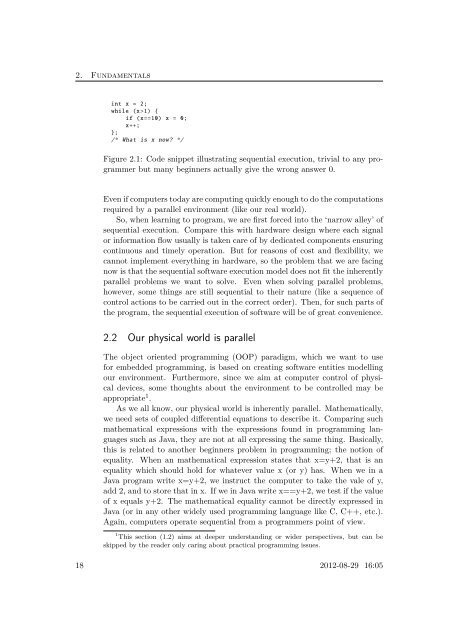JAVA-BASED REAL-TIME PROGRAMMING
JAVA-BASED REAL-TIME PROGRAMMING
JAVA-BASED REAL-TIME PROGRAMMING
Create successful ePaper yourself
Turn your PDF publications into a flip-book with our unique Google optimized e-Paper software.
2. Fundamentals<br />
int x = 2;<br />
while (x>1) {<br />
if (x==10) x = 0;<br />
x++;<br />
};<br />
/* What is x now? */<br />
Figure 2.1: Code snippet illustrating sequential execution, trivial to any programmer<br />
but many beginners actually give the wrong answer 0.<br />
Even if computers today are computing quickly enough to do the computations<br />
required by a parallel environment (like our real world).<br />
So, when learning to program, we are first forced into the ‘narrow alley’ of<br />
sequential execution. Compare this with hardware design where each signal<br />
or information flow usually is taken care of by dedicated components ensuring<br />
continuous and timely operation. But for reasons of cost and flexibility, we<br />
cannot implement everything in hardware, so the problem that we are facing<br />
now is that the sequential software execution model does not fit the inherently<br />
parallel problems we want to solve. Even when solving parallel problems,<br />
however, some things are still sequential to their nature (like a sequence of<br />
control actions to be carried out in the correct order). Then, for such parts of<br />
the program, the sequential execution of software will be of great convenience.<br />
2.2 Our physical world is parallel<br />
The object oriented programming (OOP) paradigm, which we want to use<br />
for embedded programming, is based on creating software entities modelling<br />
our environment. Furthermore, since we aim at computer control of physical<br />
devices, some thoughts about the environment to be controlled may be<br />
appropriate 1 .<br />
As we all know, our physical world is inherently parallel. Mathematically,<br />
we need sets of coupled differential equations to describe it. Comparing such<br />
mathematical expressions with the expressions found in programming languages<br />
such as Java, they are not at all expressing the same thing. Basically,<br />
this is related to another beginners problem in programming; the notion of<br />
equality. When an mathematical expression states that x=y+2, that is an<br />
equality which should hold for whatever value x (or y) has. When we in a<br />
Java program write x=y+2, we instruct the computer to take the vale of y,<br />
add 2, and to store that in x. If we in Java write x==y+2, we test if the value<br />
of x equals y+2. The mathematical equality cannot be directly expressed in<br />
Java (or in any other widely used programming language like C, C++, etc.).<br />
Again, computers operate sequential from a programmers point of view.<br />
1 This section (1.2) aims at deeper understanding or wider perspectives, but can be<br />
skipped by the reader only caring about practical programming issues.<br />
18 2012-08-29 16:05

















